The Plaza de Armas occupies the block south of the cathedral, between Avenida Morelos and Avenida Pedro Morena, on the east side of the north south axis of Avenida 16 de Septiembre. The cathedral was begun in 1558 and consecrated in 1616, but has been much altered and added to since, the style is an eclectic mix of Baroque, Neoclassical and Churrigueresque. On the left side of the picture are the facades on the Avenida 16 de Septiembre, to the right, on the east side of the plaza is the Palacio del Gobierno, finished in 1774, with a blend of Neoclassical harmony and simplicity and riotous Churrigueresque details and decorations. The south and west sides of the Plaza de Armas are lined with taller buildings, most of them with open arcades at street level.
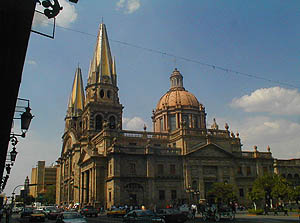
The Theatro Degollado dominates the eastern end of the long rectangle of the Plaza de la Liberacion, where it functions as an object in the space of the Plaza Fundadores on it's east side and the Jardin de Espana to the south. The Neoclassical style building features a fine 8 column porch on the west side, it was built in the 1850s and inaugurated by the Emperor Maximilian. The world famous Ballet Folklorico de Mexico often gives performances here, and tickets are usually available at the box office on the day of the event. In the southwest corner of the building there is a pleasant cafe with outdoor seating, that offers an excellent iced coffee, during my stay I went there every evening with my friend George, and we particularly enjoyed the excellent service given by cute young local girls.

The church of Santa Filomena is 4 blocks south of the cathedral and the Plaza de Armas,
and at the end of the pedestrian and shopping arcade of the Calle Colon, which runs from
the Plaza Universidad in the north to the Plaza Santa Filomena in the south. This is a
small triangular garden in front of the north facade of the church, planted with open,
airy trees and surrounded by houses and hotels. On the north side of the space the bus
from the station makes it's last stop.
The church has a tall north front with rounded edges and a single arched door, framed by
a temple front and topped with a single rectangular window. The belfry is incorporated
right into the facade, and it features a triangle of bells hung in arched windows open
to the sky, and framed with brackets, scrolls and finials.
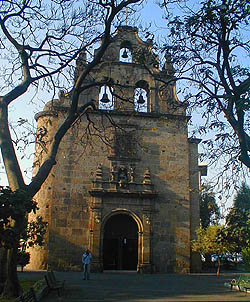
This view is looking northwest in the garden plaza on the southeast side, behind the church of Santa Filomena. Here a rectangular plaza with a fountain has been enclosed with simple round-arched arcades on 3 sides, surrounded by gardens, walkways and vegetation. At the eastern end of the arcade there are wooden booths and market stalls, offering antiques, books and artworks for sale.
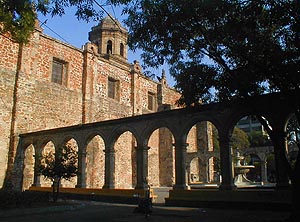
The Plaza de los Laureles, also known as the Plaza Guadalajara, faces the west front of the cathedral and functions as the Zocalo, or central plaza of the city. As the name suggests, it is planted with boxed laurels which are trimmed to cubic and geometric shapes. There is a large circular fountain in the center of the space, and a number of cafes and restaurants on the south side. This view is looking to the northwest over the fountain, and towards the Avenida Hidalgo and the Templo de la Merced.
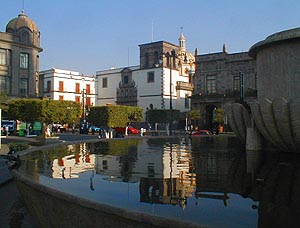
The Templo de la Merced occupies the block northwest of the Plaza de los Laureles, at the corner of Avenida Hidalgo and Avenida Pedro Loza. The temple has an elaborate portal panel on the south facade, and a single 1-story tower pavilion at the corner. There is another portal on the east side, topped by a niche and an elaborate scalloped cornice with a balustrade. There is an octagonal pavilion with a conical roof at the top, and behind this the fine dome with an octagonal drum over the crossing. The arcade is part of the Palacio Municipal, which occupies the block north of the Plaza de Laureles, and features continuous arcades on all 4 sides.
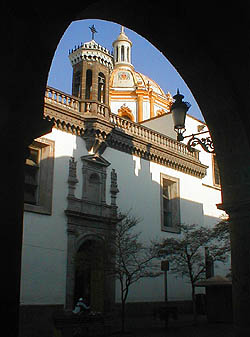
The Plaza Tapatia is a long rectangular sequence of spaces and level changes, running along the central axis from the cathedral in the west to the Instituto Cultural de Cabanas in the east. At the western end is the cathedral, with the Plaza de los Laureles on the west side, the Plaza de Armas to the south, and the Plaza della Rotonda to the north. On the east side of the cathedral is the large rectangle of the Plaza de la Liberacion, with the Teatro Degollado and the Jardin de Espana on it's east end. East of the theater is the Plaza Fundadores, then the axis cascades down into the Plaza Tapatia, with the Fuente a la Immmolacion de Quetzalcoatl at the eastern end.
